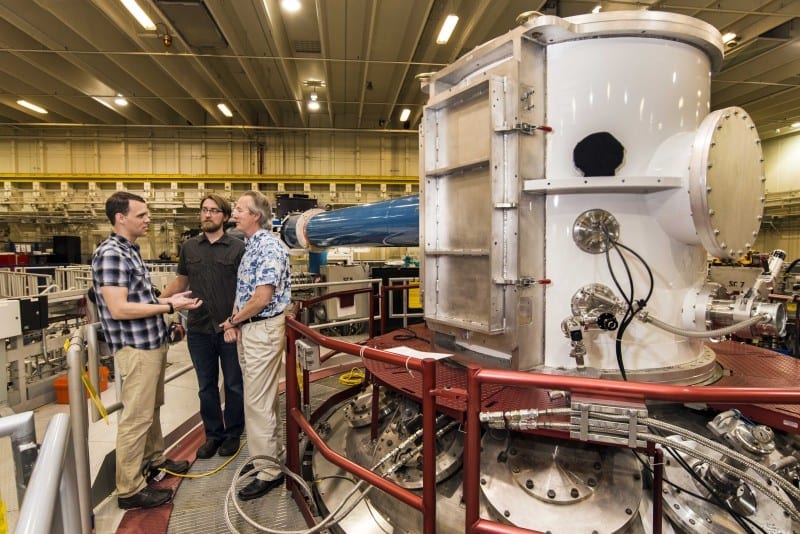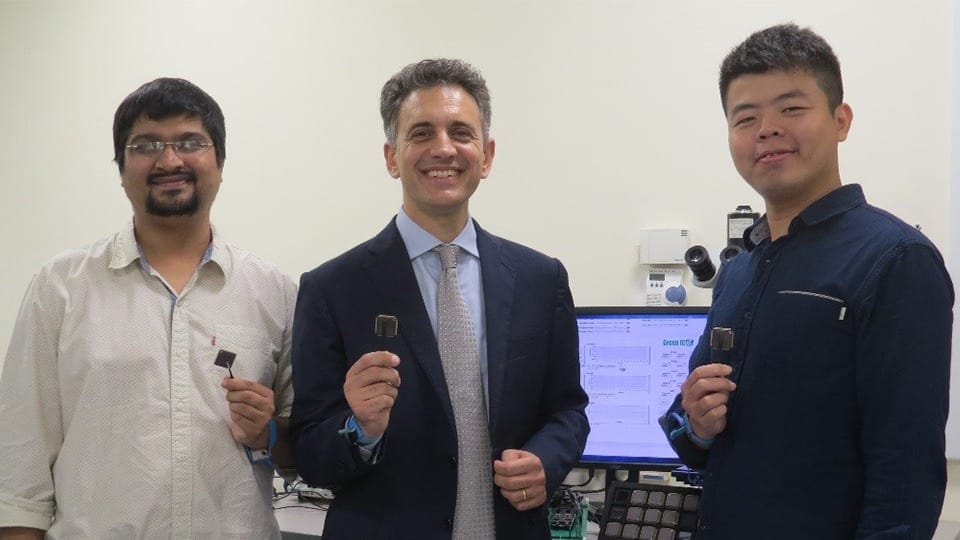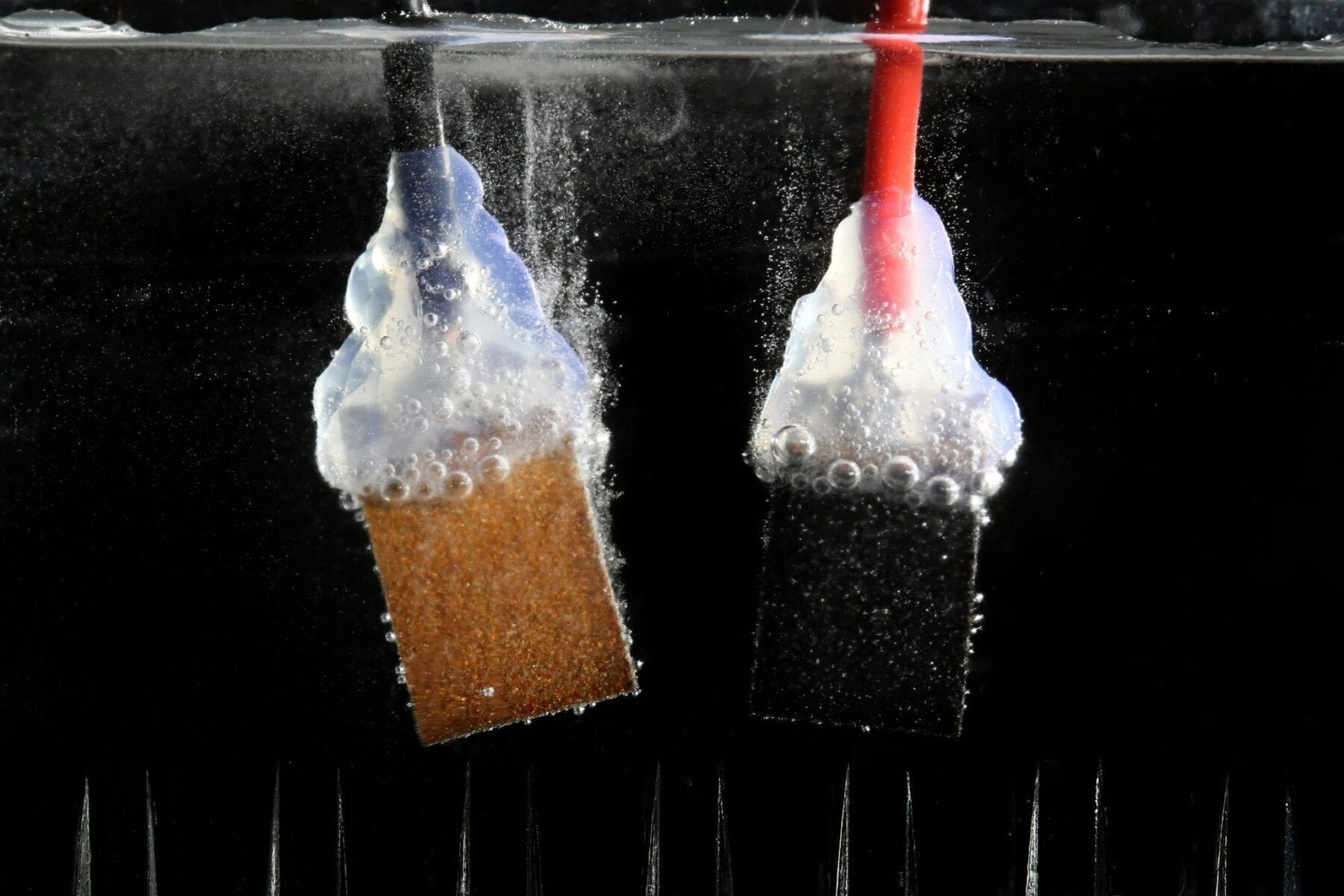
Credit: Randy Montoya
Working with two magnetic fields and a laser, all at low points of their power outputs, Sandia’s Z machine has released neutrons in an amount surprisingly close to ‘break-even’ fusion.
Researchers at Sandia National Laboratories’ Z machine have produced a significant output of fusion neutrons, using a method fully functioning for only little more than a year.
The experimental work is described in a paper to be published in the Sept. 24 Physical Review Letters online. A theoretical PRL paper to be published on the same date helps explain why the experimental method worked. The combined work demonstrates the viability of the novel approach.
“We are committed to shaking this [fusion] tree until either we get some good apples or a branch falls down and hits us on the head,” said Sandia senior manager Dan Sinars. He expects the project, dubbed MagLIF for magnetized liner inertial fusion, will be “a key piece of Sandia’s submission for a July 2015 National Nuclear Security Administration review of the national Inertial Confinement Fusion Program.”
Inertial confinement fusion creates nanosecond bursts of neutrons, ideal for creating data to plug into supercomputer codes that test the safety, security and effectiveness of the U.S. nuclear stockpile. The method could be useful as an energy source down the road if the individual fusion pulses can be sequenced like an automobile’s cylinders firing.
MagLIF uses a laser to preheat hydrogen fuel, a large magnetic field to squeeze the fuel and a separate magnetic field to keep charged atomic particles from leaving the scene.
It only took the two magnetic fields and the laser, focused on a small amount of fusible material called deuterium (hydrogen with a neutron added to its nucleus), to produce a trillion fusion neutrons (neutrons created by the fusing of atomic nuclei). Had tritium (which carries two neutrons) been included in the fuel, scientific rule-of-thumb says that 100 times more fusion neutrons would have been released. (That is, the actual release of 10 to the 12th neutrons would be upgraded, by the more reactive nature of the fuel, to 10 to the 14th neutrons.)
Still, even with this larger output, to achieve break-even fusion — as much power out of the fuel as placed into it — 100 times more neutrons (10 to the 16th) would have to be produced.
The gap is sizable, but the technique is a toddler, with researchers still figuring out the simplest measures: how thick or thin key structural elements of the design should be and the relation between the three key aspects of the approach — the two magnetic fields and the laser.
The first paper, “Experimental Demonstration of Fusion-Relevant Conditions in Magnetized Liner inertial fusion,” (MagLIF) by Sandia lead authors Matt Gomez, Steve Slutz and Adam Sefkow, describes a fusion experiment remarkably simple to visualize. The deuterium target atoms are placed within a long thin tube called a liner. A magnetic field from two pancake-shaped (Helmholtz) coils above and below the liner creates an electromagnetic curtain that prevents charged particles, both electrons and ions, from escaping. The extraordinarily powerful magnetic field of Sandia’s Z machine then crushes the liner like an athlete crushing a soda can, forcefully shoving atoms in the container into more direct contact. As the crushing begins, a laser beam preheats the deuterium atoms, infusing them with energy to increase their chances of fusing at the end of the implosion. (A nuclear reaction occurs when an atom’s core is combined with that of another atom, releasing large amounts of energy from a small amount of source material. That outcome is important in stockpile stewardship and, eventually, in civilian energy production.) Trapped energized particles including fusion-produced alpha particles (two neutrons, two protons) also help maintain the high temperature of the reaction.
“On a future facility, trapped alpha particles would further self-heat the plasma and increase the fusion rate, a process required for break-even fusion or better,” said Sefkow.
The Latest on: Fusion power
[google_news title=”” keyword=”Fusion power” num_posts=”10″ blurb_length=”0″ show_thumb=”left”]
via Google News
The Latest on: Fusion power
- UK seeks industry partners for fusion power planton May 8, 2024 at 11:21 pm
The government has launched a competition to find industry partners for the UK's prototype fusion energy plant ...
- Taxpayers to fund fast-tracked nuclear fusion reactorson May 8, 2024 at 8:59 am
Pioneering nuclear fusion power plants are to be fast tracked through the planning process and supported with taxpayer money as Britain attempts to become a world leader in the technology. Under new ...
- National Fusion Facility Completes Upgradeon May 8, 2024 at 8:01 am
Enhancements will enable research into the physics of advanced fusion reactors and accelerate the drive to commercial fusion energy. The DIII-D National ...
- DIII-D National Fusion Facility Completes Upgradeon May 8, 2024 at 3:30 am
FPPs and future power plants will require much more powerful systems to create and drive the fusion reaction. The new, more efficient systems added to DIII-D will allow researchers to access plasma ...
- Researchers use superconducting material to make clean fusion energy breakthrough: 'Virtually limitless power production'on May 7, 2024 at 8:52 pm
Scientists at the MIT Plasma Science and Fusion Center reached what university press described as a "major milestone" in the realm of fusion power plants. The breakthrough could "usher in an era of ...
- An 'artificial sun' achieved a record-breaking fusion experiment, bringing us closer to clean, limitless energyon May 6, 2024 at 4:26 pm
WEST, a fusion reactor in France, broke a record for tungsten tokamaks with a 6-minute plasma. It's an important step toward clean, limitless energy.
- New Fusion Record Achieved in Tungsten-Encased Reactoron May 6, 2024 at 11:51 am
A fusion device ensconced in highly durable tungsten sustained a more energetic, denser plasma than previously recorded.
- Fusion record set for tungsten tokamak WESTon May 6, 2024 at 8:01 am
Princeton Plasma Physics Laboratory (PPPL) measured a new record for a fusion device internally clad in tungsten, the element that could be the best fit for the commercial-scale machines required to ...
- Private Investment Fuels Race For Nuclear Fusion Power In USon May 5, 2024 at 10:07 pm
Spurred on by major technological advances and huge private investment, the United States' nuclear fusion sector could be producing electricity within ten years, industry players say.
- Two seconds of hope for fusion poweron May 3, 2024 at 9:11 am
Using nuclear fusion, the process that powers the stars, to produce electricity on Earth has famously been 30 years away for more than 70 years. But now, a breakthrough experiment done at the DIII-D ...
via Bing News










